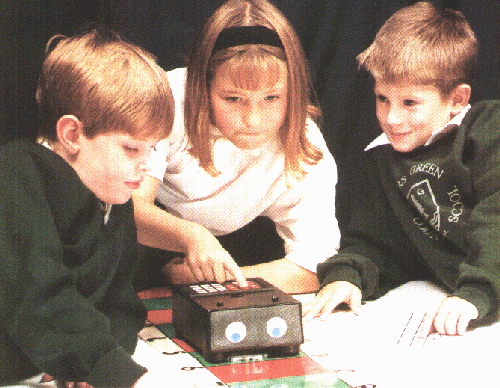|
|

PIP is our bigger, more sophisticated, independent programmable robot. It is 225 mm long with 24 keys. It is intended for use at KS1 and KS2 for maths, control, pre-LOGO learning and cross-curriculum projects.
PIP's commands are:
FORWARDS up to 999 units BACKWARDS up to 999 units LEFT up to 999 units RIGHT up to 999 units FLASH (both
LEDs) up to 999 times PAUSE up to 999 units RePeaT up to 99 times MUSICAL NOTE C,D,E,F,F#,G,A,B,C,D END repeat sequence Clear
Entry Clear
Memory Restore
Memory Go start program Test Execute last program
entry
There are 10 digit keys which are also labelled with
musical notes. When used correctly, these beep with the
pitch of the relevant note.
If PIP can understand a keypress, it gives a beep and flashes the LEDs. If it cannot understand because of a syntax error, PIP grumbles and does not flash the LEDs.
When PIP's memory is full it will grumble if more program keys are pressed.
Programming PIP is a matter of entering a command key (left column above) followed by one or more number keys. So you enter what PIP should do, followed by how much of it PIP should do. This is repeated until the whole program is entered.
If you enter number keys when you should be entering a command key or vice versa, PIP will grumble and ignore the keypresses.
As PIP uses numbers in this way, children will rapidly learn the significance of digit position and relative size. So, for example, they will find that "33" (3 repeated) is more than 10 times bigger than "3". Using single digits, it becomes clear that "8" is bigger than "5" by experiment.
One of the simple things that can be done with PIP with younger children is to find out experimentally how much turn makes PIP go "all the way round". If PIP is set up for 1 degree turn units, the children will rapidly learn that 360 is the right number. The interesting thing is the trial and error process that leads to this.
Young children may start with a turn of 10 degrees and see how small that is. Rather than immediately step to a number of perhaps 400, scaled up from the amount of turn they started with, they will often go up in steps of 10 degrees. They have not yet achieved an understanding of proportion. PIP is a useful tool for them to learn about proportion from an experimental point of view.


